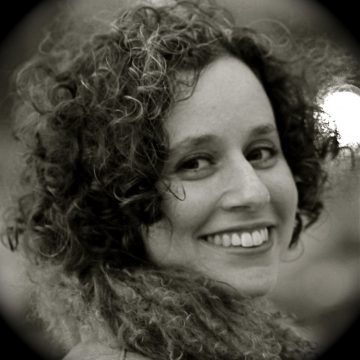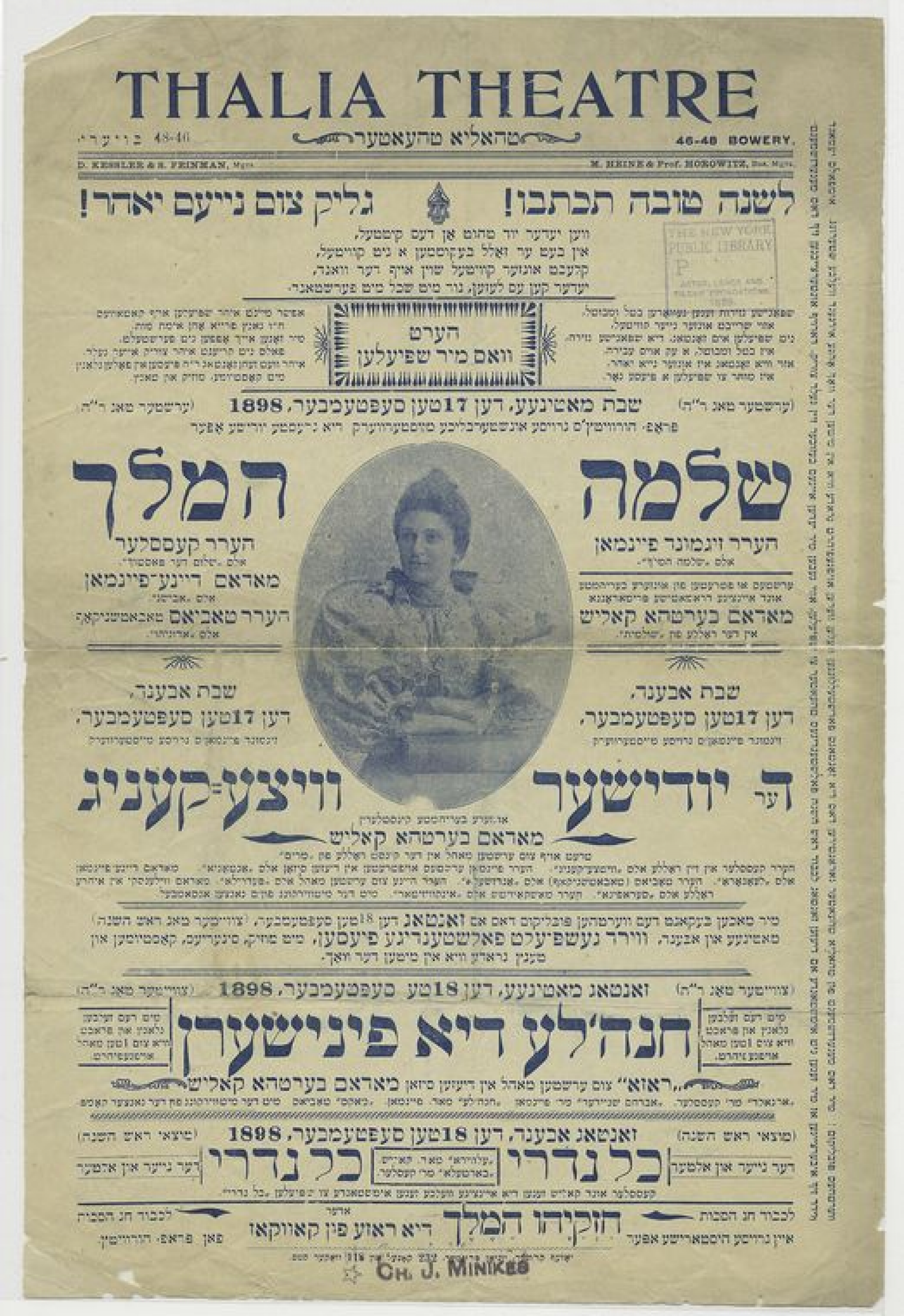
Shloyme ha-meylekh [Shelomoh ha-melekh], September 17, 1898. NYPL Digital ID 435106
Yiddish Theatre Posters of the 1890s
Amanda (Miryem-Khaye) Seigel
The New York Public Library’s Digital Collection includes Yiddish theatre posters dating back more than a hundred years. These ephemeral pieces, with their bold titles, portraits of actors, and exuberant descriptions of plays, illustrate the dynamic Yiddish theatre tradition in two major centers: New York and Buenos Aires. Together with hundreds of manuscripts, photographs, books, periodicals, and sheet music, they comprise one of the largest Yiddish theatre collections in the world.
“Hell and Heaven”
The earliest posters utilize detailed illustrations, such as this one for “Gehenem un gan-eydn” (literally, “hell and heaven”) by Abraham Goldfaden, starring Morris Finkel (pictured), who was also the director and business manager. This “famous comic opera” of January 8, 1891, at the Romanian Opera House in New York, promises new decorations, costumes and scenery. Sheet music for a duet from the opera was published in 1897. In a truly hellish twist, Finkel later shot and disabled his wife, Emma Thomashefsky Finkel (sister of Boris Thomashefsky) and then killed himself in a grisly real-life tragedy that shocked the Yiddish theatre world.
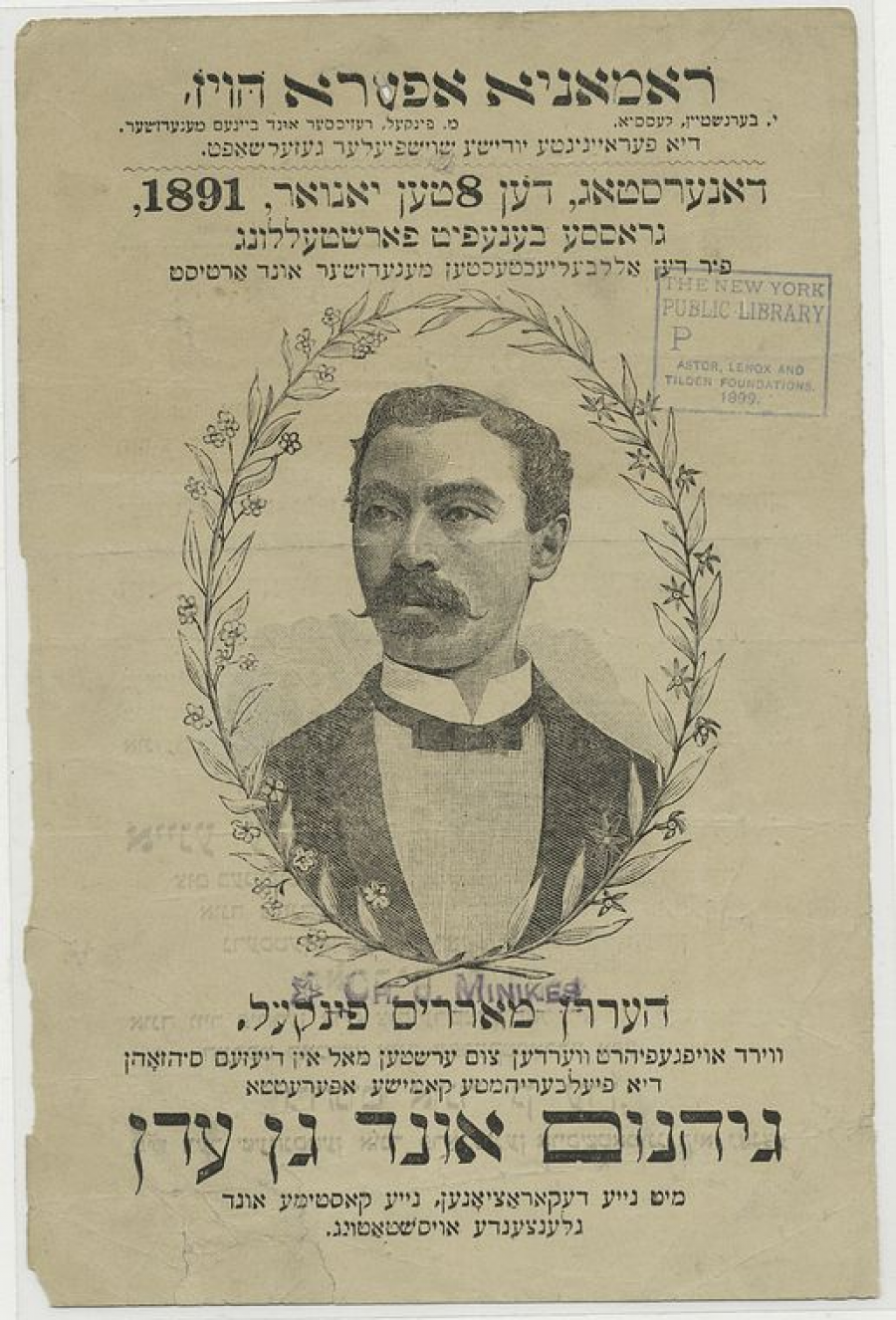
Gehenem un gan-eydn starring Morris Finkel, January 8, 1891, at New York’s Romanian Opera House. NYPL Digital Image 435120
“Positively the last production”
The placard below advertises “Kidesh ha-shem” [literally, “sanctification of the name”], a historical drama about Jewish martyrdom by the Yosef Latayner, an ever-prolific playwright known for the quantity, rather than the quality, of his work. Starring Sigmund and Dina Feinman (pictured), the cast included other heavyweights like Boris and Bessie Thomashefsky, Bertha Kalich, Sophia Carp, Rudolph Marks and [Max] Rosenthal. This was “positively the last production”, with performances scheduled for Friday and Saturday, October 30 and 31, [1891?].
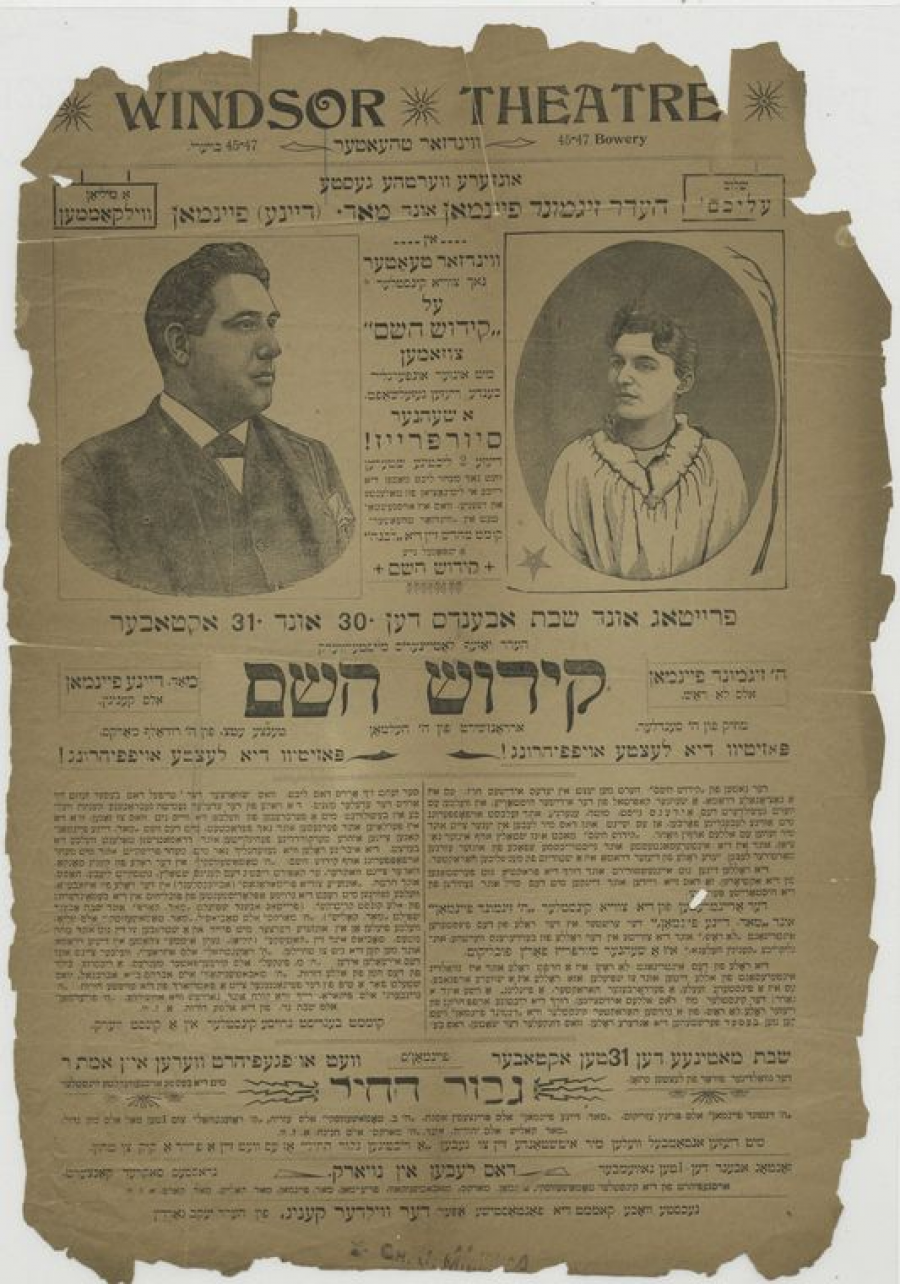
Kidesh ha-shem, starring Sigmund and Dina Feynman. NYPL Digital Image 435096
Pioneering Prima Donna
The benefit advertised below was held on Thursday, January 5, 1893 at the Thalia (formerly Bowery) Theatre, a popular early Yiddish venue at 46-48 Bowery, whose gallery is home today to the Jing Fong Chinese restaurant. The beneficiary, Sophia Karp (1859-1904), was probably the first Yiddish actress, starting her career at age 16 with Abraham Goldfaden and being the first to sing the famous “Eli, eli, lomo azavtoni” (later recorded by Belle Baker). The brochure’s extremely Daytshmerish text (a prententious Germanic style of the time meant to convey sophistication) proclaims Karp’s status as a prima donna of the “Yiddish-German” theatre of New York and invites audience members to an (unnamed) opera. The benefit performance - both for actors and for charitable organizations - was a frequent occurrence and helped to guarantee an audience on weekdays.
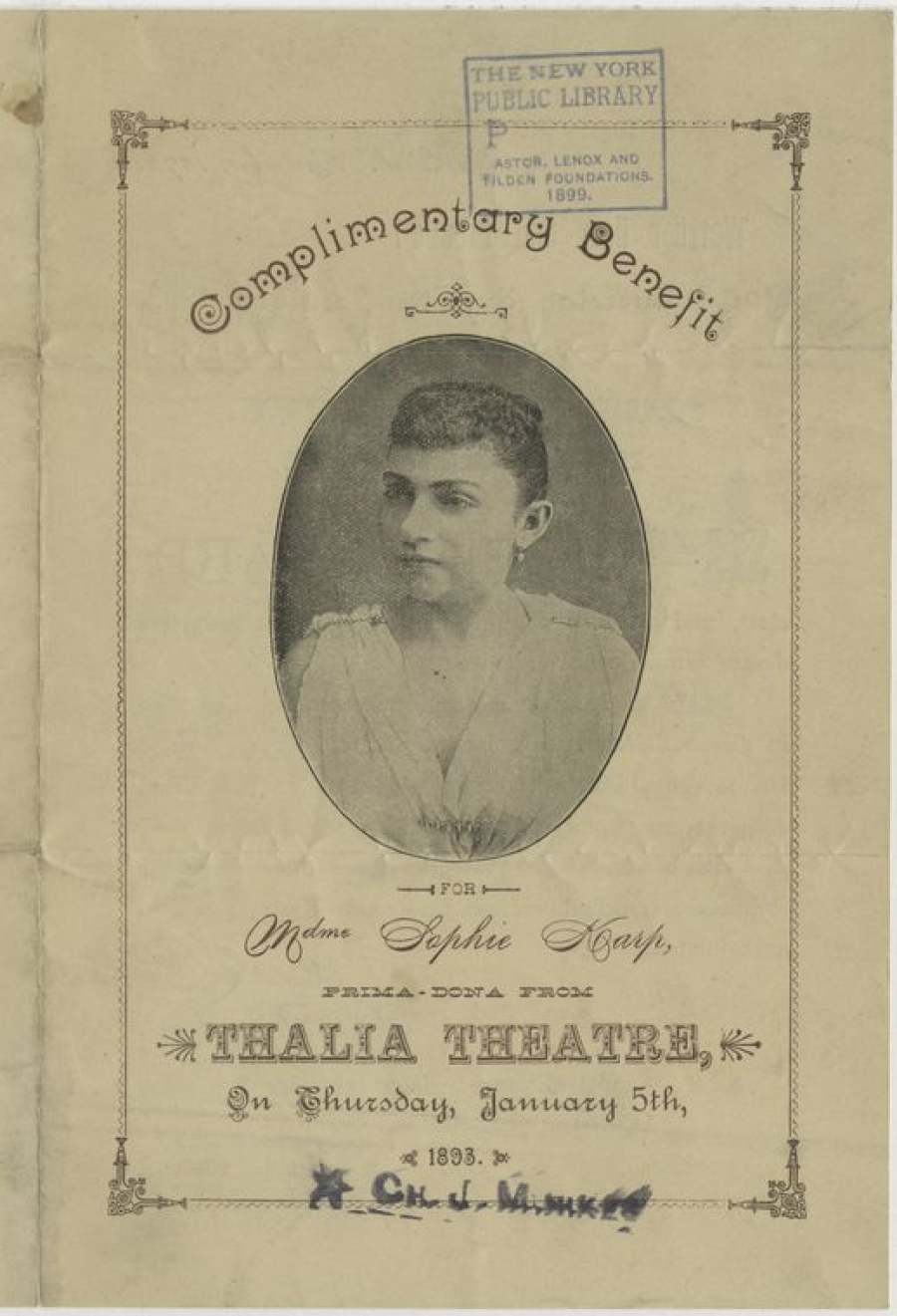
January 5, 1893 benefit poster for Madame Sophie Karp. NYPL Digital Image ID: 435095
For “Appreciators of True Art”
Speaking of Daytshmerish, this next poster for “Di zilberne hokhtsayt” [The silver wedding] use the German “hochzeit” instead of the Yiddish “khasene” for the word “wedding”. The text admonishes “appreciators of true art… not to miss this evening….which each person can only enjoy once in a lifetime”.
“Di zilberne hokhtsayt” was based on a popular Russian melodrama, Vtorai︠a︡ molodostʹ [Second Youth] by P.M. Nevezhin and featured Boris Thomashefsky, Sophia Karp, the comic Berl Bernstein, Madame Epstein, Mr. Conrad, Dora Dubinski and Sabina Weinblatt.
The “Fereynigte Idishe Shoyshpiler Gezelshaft” [United Yiddish Actors’ Society] sponsored this benefit performance on January 30, 1894 for the play’s author/adapter, Yaakov Ter (1850-1935, pictured) who sold tickets at his home at 39-41 Suffolk Street. Ter, whose name stamp appears on the right, donated Yiddish theatre ephemera to NYPL, along with Chonon Jacob Minikes and Boris Thomashefsky.
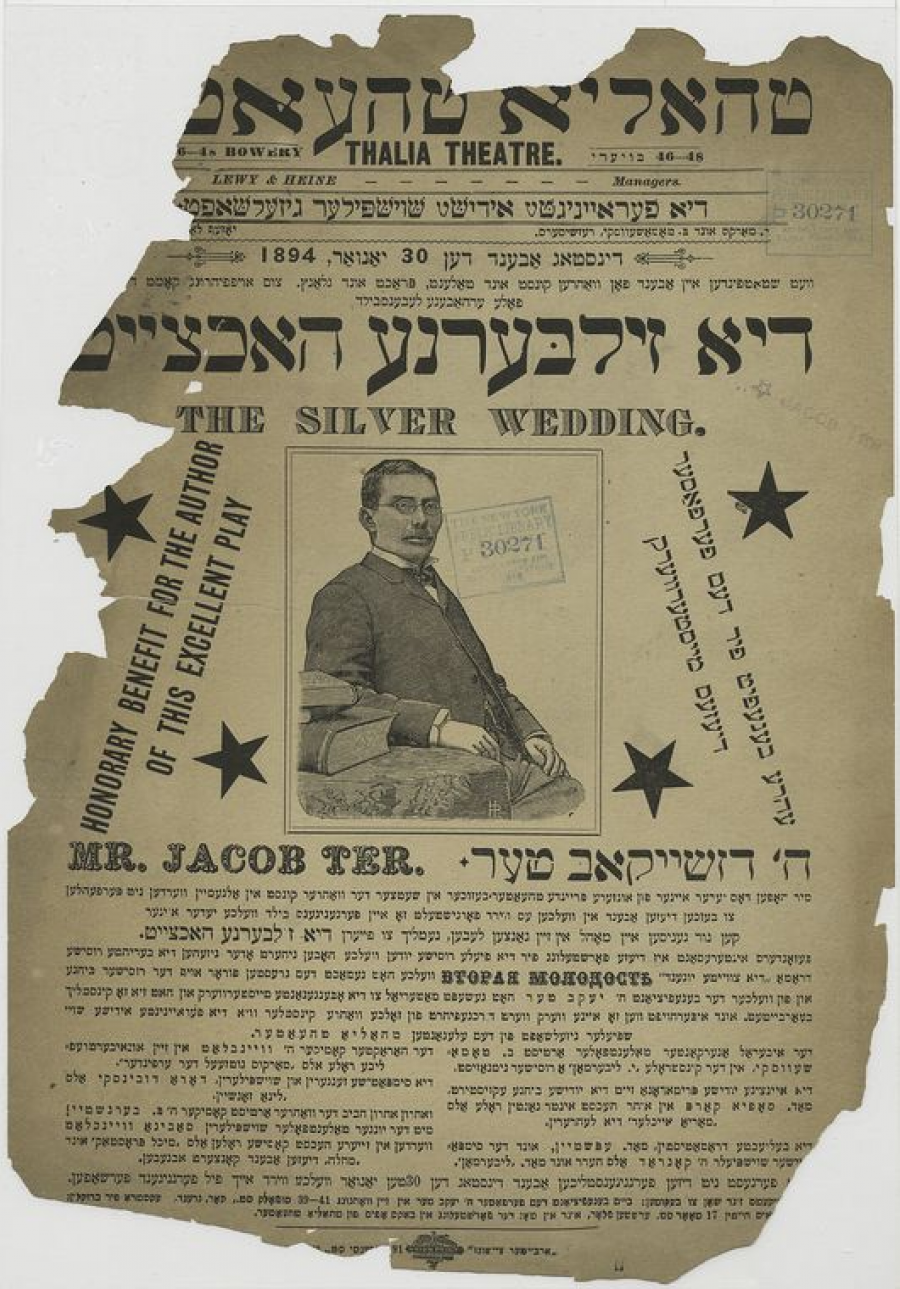
Di zilberne hokhtsayt. NYPL Digital Image 435134
Rosh Ha-Shanah Openers of 1898
From Friday night and Saturday performances, to High Holiday openers, the Yiddish theatre mirrored (and for some, replaced) the synagogue. The poster below contains the traditional Rosh Ha-Shanah wish “Leshone toyve tikoseyvu” [May you be inscribed for a good year] and uses rhymed verses, like the Rosh Ha-Shanah cards of the time, to describe the performances scheduled on the holidays.

Shloyme ha-meylekh [Shelomoh ha-melekh], September 17, 1898. NYPL Digital ID 435106
Legendary actors Bertha Kalich (pictured) and David Kessler appeared in a performance called “the new and old Kol Nidre” by A. Sharkanski, named after the Yom Kippur prayer. Bertha Kalich had already sung for Yom Kippur services in Bucharest, a terrifying and elating experience she describes in her memoirs in the newspaper Der Tog on July 8 and 11, 1925. As for Sharkanski’s play, you can read it online and find associated sheet music by Louis Friedsell at NYPL and the Library of Congress.
The busy holiday season also included performances of “Shloyme ha-meylekh” [King Solomon] and “Hizkiyahu ha-meylekh, oder, di roze fun Kavkaz” [King Hezekiah, or, the Rose of the Caucasus] by another mass-market hack, “Professor” Moyshe Hurwitz; plus “Di Yudishe Vitse-Kenig” [The Jewish Viceroy] by Sigmund Feinman and “Khanele di finisherin” [Khanele the Finisher]. Participating stars included Sigmund and Dina Feinman, Shmuel Tabatshnikov (Samuel Tobias), Hayne, Mary Wilensky, and Moshkovitsh.
For more Yiddish theatre ephemera, visit these sites:
- Digital Collection, New York Public Library
- Digital Collection, Center for Jewish History
- Yiddish Theatre, Museum of the City of New York
© The New York Public Library
